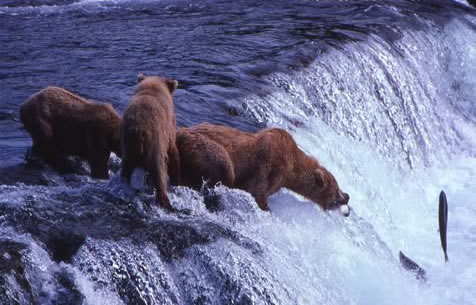Post by warsaw on Mar 19, 2015 14:25:42 GMT -9

Huge Brown Bear walking past Brooks Lodge Ranger Station July 17 2007












How Many Bears Frequent Brooks River?
During late June through July the annual cumulative total
number of independent bears identified regularly using
Brooks River during 2004-2008 has ranged from 43 to 70.
During September through early October, the annual cumulative
total has ranged from 45 to 59. Typically, another
5 to 10 transient bears have also been documented in each
of the two monitoring periods annually. There are several
factors that may be related to the increasing trend in bear
numbers at Brooks, including:
• Over the past 20 years, increasing management emphasis
has been placed on minimizing bear-human conflicts.
Over their lives, the experience of cubs that accompanied
their mothers to Brooks may consist largely of relatively
benign contacts with people there. Thus, we would expect
the number and proportion of adults tolerant of people to
increase
Salmon runs have been generally strong throughout the
region during the past 20 years. In the Naknek River watershed,
which includes Brooks River, the Alaska Department
of Fish and Game has reported a 20 year average escapement
of 1.8 million fish (1989–2008). During this same
period, weather conditions have been relatively mild. Bear
survival and productivity may have increased as a result.
• Brooks River is one of the first streams in Katmai where
migrating salmon become accessible to bears (and the
caloric value of bright pre-spawned salmon is exceptionally
high). In contrast, spawning and spawned-out salmon
are available at several streams during fall. Differences in
adult male representation between July and fall may in part
reflect this seasonal distribution of resources.
Death of a Bear
Wild bears are subjected to many risks during their lives.
Starvation, spring time avalanches, illness, injury, and
predation are just some of the reasons that bears may die.
Outside the boundaries of Katmai National Park, bears
can be hunted for sport and subsistence, and humans are
significant cause of mortality for bears in many areas of the
world. In contrast, Katmai National Park is one of the few
places where the population of brown bears is naturally
regulated.
Dead bears are rarely found in the wild. Even in Katmai, a
place with some of the highest densities of bears anywhere
in the world, rangers and biologists rarely see a bear die or
find dead bears. Still, the information gathered by biologists
in the past that can help us glean some knowledge about
the end of a bear’s life.
Around the Brooks River, bears have been seen killing
other bears, like subadults and cubs, on rare occasions and
in 2008 one bear was observed dying in the Brooks River
(see bear #219 on page 54).
One study on the Pacific coast of Katmai recorded 17
natural mortalities of female bears from 1989-1996. Eight
of those 17 adult females were killed by other bears. One
female apparently died of starvation and one died after
being caught in a spring time avalanche. Six females died
www.nin the spring, six died in the summer, and four died in the
fall. During that same study period, one adult male and
subadult male were found dead and both appeared to have
been killed by other bears.
While brown bears can live more than 30 years, they commonly
live 20 years or less. Most bears, however, live short
lives. While Katmai may have some of the highest densities
of bears in the world, it also has one of the highest mortality
rates for cubs. Two out of three cubs may not survive
their first year.
From 1989-1996, 99 cubs from 48 litters were tracked via
different radiocollared females. 61 of those cubs were lost,
including 11 mothers, indicating that the survival rate of
females with cubs is lower than single females. This is a
very low (0.342) survival rate for cubs, one of the lowest
ever measured in North America.
Katmai’s bears live in an unforgiving world, and it can be
hard to watch an adult bear or cub die. As wild animals,
they receive no veterinary care or preventative medicine.
Bears have evolved to bear tough and resourceful animals,
but their lives do come to an end, sometimes peacefully
and sometimes painfully
Due to their large size and strength, no other
class of brown bear is able to compete physically
with a large adult male.
They can stand 3-5 feet (.9-1.5 m) at the shoulder
and measure 7-10 (2.1-3 m) feet in length.
Most adult males typically weigh 600-900
pounds (272-408 kg) in mid-summer. By October
and November, large adult males can weigh
well over 1000 pounds (454 kg).
The best fishing spots at Brooks Falls are dominated
by adult males. Hierarchy and displays of
dominance play important roles in preventing
these animals from entering into violent battles.
Wounds, and their associated scars, are often
received during fights with other males. These
fights can be the result of competition for food
resources (access or appropriation) or for the
opportunity to mate with females.
www.nps.gov/katm/learn/photosmultimedia/upload/Bears-of-Brooks-River_web.pdf
Bear 854, "Divot", a bear regularly seen at Brooks Camp in Katmai National Park, is discovered with a wolf snare around her neck. In response, the park mounted a mission to save the bear and her cub.
"As wild animals,they receive no veterinary care or preventative medicine,with the exception of injury caused by humans (i.e wolf snare around her neck)

The Resilient Bear
July 14, 2013 Posted by: Michael Fitz
Watching the bearcams on explore.org gives anyone with internet access an opportunity to experience the dynamics of a bear’s world. We get to observe the playfulness of cubs, the intimacy of mating, and the satiation of hunger when a bear eats a salmon. However, when we watch the cams, we will also see some unpleasant aspects of the bears’ world.
Cubs and younger bears may be killed by a larger, more aggressive bears. Older bears and injured bears may struggle to catch enough salmon to survive a long winter and lean spring. Injured bears often appear to be in obvious pain. These are difficult scenes to watch, and over the past few days one bear at Brooks Falls has obviously struggled with a significant injury. It may be difficult to watch this bear struggle with his impaired mobility, but like other injured bears he is also giving us a glimpse into the resiliency and adaptability that bears posses.
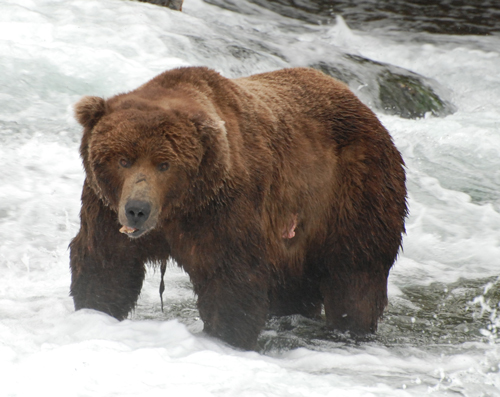
#420 in July 2007 with a broken jaw and open wounds on his side.

ID Marks
and Hints
#420 is easy to identify due to his protruding
teeth on his lower-right jaw.
His is a long, large bodied bear with a blocky
muzzle, rusty brown coat, tan-brown claws, and
a floppy left ear.
He can be confused with Bear #247, but that
bear is smaller and only has one protruding
canine tooth on his left jaw.
#420 was aggressive around other bears and
regularly stole fish.
In 2005, he was seen with a very large, open
wound on the left front leg that has since healed
and scarred over. In 2007, he returned to the
Brooks River with a broken lower jaw and large,
open wounds on both sides of his body.
The jaw injury appeared to affect his ability to
chew and swallow fish that he caught. However,
he showed signs of rapid healing, both from the
jaw injury and the wounds on his body.
In 2009 and 2010, he was one of the more dominant
bears fishing at Brooks Falls.
Even though #420 was typically very dominant
at Brooks Falls, he did not appear to be habituated
to humans and rarely approached the Falls
Platform side of the river. He was last observed
in 2010
In July, 2007, #420, nicknamed Genghis, arrived with a broken jaw and large open wounds on each side of his body. Before these injuries, he was a fairly dominant bear often stealing fish from other bears and/or displacing them from preferred fishing spots. With his broken jaw, he was no longer very dominant. Although smaller bears did not challenge him, he would not challenge other bears. His injuries lowered his position in the Brooks Falls hierarchy.
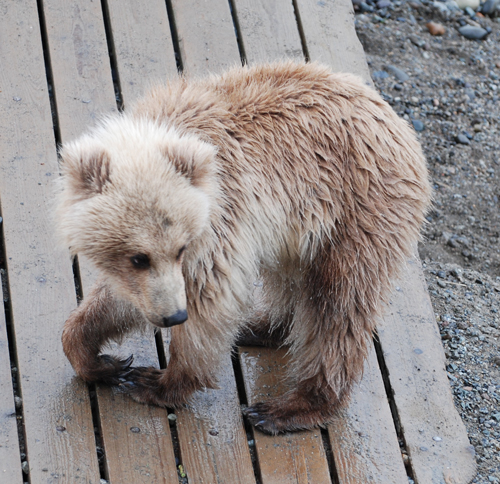
#435's yearling cub limped on an injured leg for most of the summer in 2007.
Around the same time in 2007, #435, nicknamed Holly, arrived with a yearling cub. The cub was limping noticeably, and it would put no weight on one of his front legs. With impaired mobility, this bear family was competitively disadvantaged. #435 would not visit Brooks Falls to fish and the cub would not be able to flee any threats.
Many people wondered, will these bears survive and will someone help them? Park rangers and biologists will not intervene to help an injured animal. “Bears injured naturally will not be tranquilized for veterinary care” (Katmai National Park Bear-Human Conflict Management Plan, 2006). Injured bears will also not be euthanized unless they pose an imminent threat to human safety. Will they survive? That was something, at the time, we could not answer.
Both #420 and #435 plus yearling modified their behavior to deal with the injuries. #420 would not steal fish in early July, but he still used his size to maintain a good fishing spot at Brooks Falls. By gingerly chewing salmon on the unbroken side of his mouth, he was able to maintain his weight and size. In 2009 and 2010, he was one of the most dominant bears at Brooks Falls.
#435 reacted to her yearling’s limited mobility by fishing around the mouth of Brooks River where larger, more aggressive bears are less frequently seen. She also appeared to move more slowly to allow the injured yearling to keep pace. By September, 2007, the yearling’s leg had healed. In 2008, the former yearling cub was seen as an independent bear and no sign of the injured leg. He is now #89 (Backpack) a young adult male who is frequently seen on the Falls and Lower River cams.
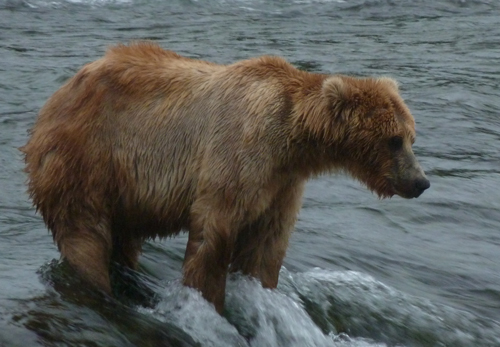
#435's limping cub in 2007 is now a healthy looking adult male.
This year #469, is frequently seen slowly moving around Brooks Falls. His left hind leg and foot are swollen. The bear moves slowly, using its three other legs as crutches. Even when standing still, the injured leg bears no weight
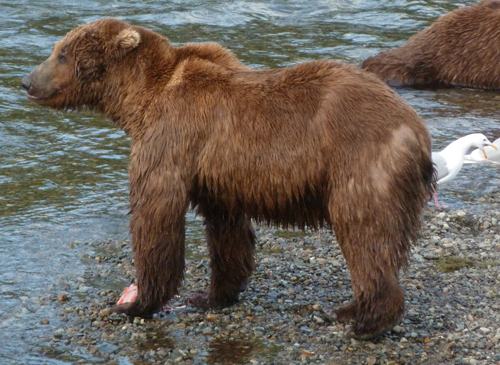
In early July 2013, #469 arrived at Brooks Falls with a severe limp. This bear often had trouble moving through the river and maintaining prime fishing spots.
We don’t know how this bear was injured, nor do we know when he was injured. Since 2001, he has only been seen in the fall, never in July. Perhaps this change in habit is a result of the injury. #469 may have to take additional risks around other bears and people at Brooks Camp in order to eat and heal.
These are three bears with three stories to tell. #420 and #89’s stories show how bears are able to modify their behavior and movements to deal with injury. These are adaptable and resilient animals. Of course, we don’t yet know the outcome of #469’s story, but he may yet provide us with another example of a bear’s remarkable ability to adapt, heal, and survive.
Michael Fitz - Katmai National Park and Preserve, Alaska
comments
wendy - alpharetta, ga
October 15, 2014 at 11:41
Ranger Mike. There are cams out in the Northwest where have rescued cubs abandoned by moms or injured. They are rehabed with other cubs. They might have 6-7 time. I noticed on amcomment on the Katmai explore site where it said only about 4of 8 cubs will survive. why wouldn't the park service there do what is done in other areas with cubs? Also with such abundant food why such a high perish rate for the cubs?
Michael Fitz - Katmai National Park and Preserve, Alaska
October 20, 2014 at 07:05
@wendy: Sorry for the tardy reply, but your comment caught me on a long weekend. To answer your second question—no one really knows why so few cubs survive into adulthood, but a host of possibilities can easily be listed. Bears, in general, have low reproductive rates. It’s not just food availability that affects cub survival, but also competition amongst bears. In some areas of the park where there are very high densities of bears, there may be little room for a newly weaned bear to find food without facing stiff competition from many other bears. Bears will also kill other bears. Mother bears do their best to ensure their cubs survival, but they can only sacrifice so much for their offspring. If a cub is too sick or injured to keep up with mom, then it might become abandoned. Accidents happen too. A cub can drown, or fall out of tree, or just get lost. There are a few reasons why the NPS doesn’t rescue and rehab abandoned and/or injured cubs. In the post above, I tried to articulate the many of reasons behind this. To summarize—1. Policy: The NPS aims to maintain natural processes in the areas that we manage. 2. Feasibility: There just aren’t enough zoos or rehab centers to care for all injured and orphaned bears. 3. Expense: It is very expensive to care for these animals. 4. Need: Katmai’s bear population is thought to be healthy enough that we do not need to take measures to increase it. 5. Bears are tough: Most never need our help, even the injured or sick. Personally, I think that bears need to be given the chance to live like wild bears. If, for example, we had captured and sent 89 Backpack to a rehab center he’d likely be living his life in captivity instead of the life of a wild bear. If, to cite another example, we would have captured 402’s abandoned cub this year and sent it to a zoo, then it would not have had a chance to get adopted by 435 Holly. We would not have had the opportunity to witness and learn from that rare and unique event. These are fascinating stories that demonstrate bears’ adaptability, resourcefulness, and resiliency I realize that it can be hard to watch an injured or abandoned cub struggle to survive, but that is part of the bear world. If given a chance, the lucky, strong, and fit bears will survive to pass on their genes to the next generation and Katmai’s bear population will be healthier for it.
www.nps.gov/katm/blogs/The-Resilient-Bear.htm

www.flickr.com/photos/katmainps/
two bears mating in mid July in Brooks Falls

grizzlybearblog.wordpress.com/tag/grizzlies/page/4/
Photo of Grizzly Bears Fishing Brooks Falls
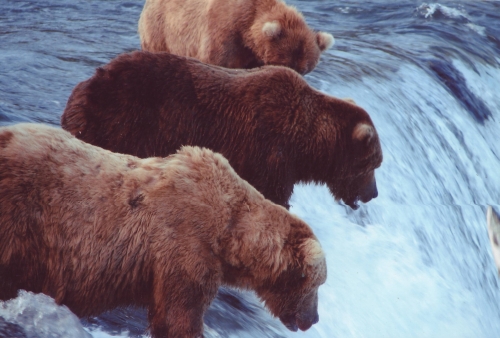
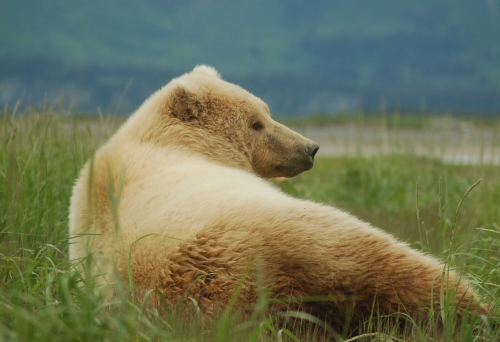
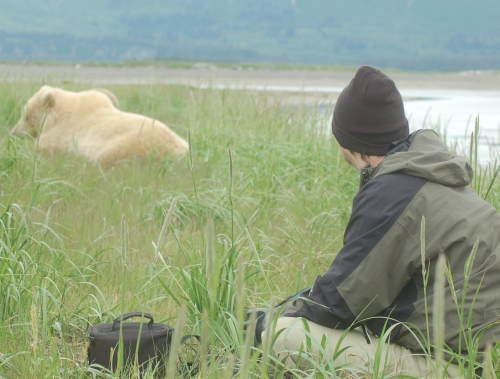
A closer photo of Cheetah as she wakes up from her nap. She has sleepy eyes, and mud on her face from a brief altercation in the creek bed with a curious, young male bear. Unlike with the male bear, Cheetah had no problem getting very close to us humans. She had walked right up to us earlier, and then later settled down near us to take a nap in the grass.
Cheetah has spent much of her life around bear viewing tourists and has become comfortable with their presence. She is quite respectful when approaching people, and will immediately halt and veer away if you tell her “that’s close enough” or “no”. I’m still trying to figure out how to tell her “don’t come any closer, but don’t run off either!”
grizzlybearblog.wordpress.com/category/cheetah/
Grizzly bear fishing for salmon at Brooks Falls, Alaska

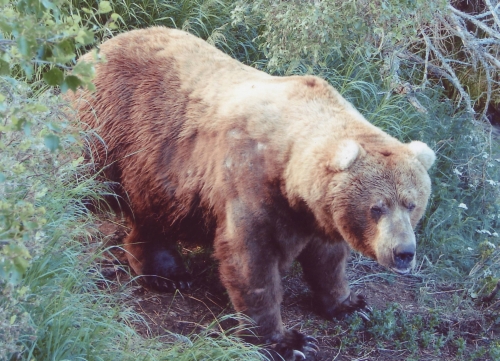

Mother Bear and Cubs – Brooks Falls, Alaska
